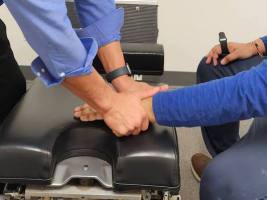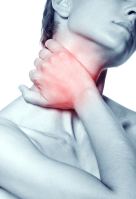
Chiropractic Newsletter
What is Whiplash?
Whiplash is a neck condition caused by a rapid and involuntary back-and-forth movement in the neck.
This sudden movement may be caused by different scenarios, such as sports or car accidents. While whiplash is normally restored within a couple of weeks of special treatment, some patients may have chronic pain and other related symptoms.
Common Symptoms
It’s important to understand that most symptoms do not appear right after the incident that causes them.
Therefore, you may notice a bad whipping movement of the neck and not feel anything wrong until 6 to 12 hours after that instant. Common whiplash symptoms include:
• Neck problems such as stiffness, swelling, or pain. It may also cause difficulty in moving your head upward, downward, or to either side.
• Headaches and difficulty focusing on a task.
• Numbness in limbs, such as your arms, but also including your hands and shoulders.
• Vertigo or tinnitus, which resembles a ringing in the ear.
• Tiredness, dizziness, or blurred vision.
Note that feeling these symptoms may not always mean that you have whiplash. However, other signs may indicate that this is the main cause, such as memory problems, depression, and trouble sleeping.
What Causes Whiplash?
One of the most common causes of whiplash is that of dangerous sports that require physical contact, such as boxing, football, and rugby.
However, other non-contact activities may also lead to sudden movements of the neck and, therefore, whiplash. This includes car racing, alpinism, and speed running. Other common scenarios where whiplash-related movements may be found are car crashes, assaults, slipping, falling from high heights, and other similar ones.
How To Treat Whiplash?
Whiplash levels may vary based on the activity where it occurred, and the seriousness of the movement caused by such a scenario. It is a wise choice to see your doctor, such as your chiropractor, acupuncturist, or PCP, if you are experiencing new neck pain. Your doctor may:
• Palpate the area to feel changes in the tissue
• Do an adjustment
• Cup the neck and upper back
• Acupuncture the neck, upper back, and other areas that impact whiplash
• Apply cold packs repeatedly for short periods
• Use Kinesio taping
If these treatments do not alleviate the pain over time, your doctor may suggest having imaging done of the neck.
If you have been involved in a scenario with chronic whiplash symptoms, consult with us soon for professional guidance.
Speaking on the Phone for Extended Periods and the Problems it Creates
Speaking on the phone is a daily activity for most people. We tend to do it with friends, colleagues, and family, and whenever we need to hire a service. However, extended periods on the phone may affect your health.
Common Problems
While phone conversations may seem harmless, they may bring a variety of health issues if you do it for long periods. These effects apply to both traditional phones and smart devices. Here are the 5 most common problems people may suffer due to speaking on the phone for extended periods.
1. Numbness in the hand: The posture while holding the phone is not natural.
Therefore, blood irrigation may be affected when done for extended periods. This may cause your hand to become numb. Prolonged numbness is a clear sign of dysfunctional blood circulation.
2. Cubital and carpal tunnel: If you’ve ever heard about “text claw” or “cell phone elbow”, they are popular names to refer to cubital tunnel syndrome and carpal tunnel syndrome.
3. Repetitive strain injuries: As with other repetitive and unnatural positions caused by daily activities, prolonged phone usage can cause pain or discomfort.
4. Weight gain: In a weird way, using the phone for extended periods can cause people to gain weight. This is thought to be due to lack of activity and movement.
While speaking on the phone, people may not get sufficient physical exercise. Using the time for walking, jogging or running could be more beneficial instead.
5. Neck and upper back pain: While using the phone, we unconsciously adopt unnatural body postures. If recurring and for long periods, our neck and upper back may start to ache. Overtime, this can lead to more chronic problems.
While avoiding using the phone is one of the most common, but not always realistic fixes, there are other measures people may adopt.
• Look for a relaxed place to speak on the phone: When possible, try to look for a place where you can sit and relax while you speak on the phone.This will help you avoid adopting unnatural postures that may harm your back and neck.
• Use hand-free devices: Using hand-free devices, such as Bluetooth or speaker functionalities, may help you avoid involving your hand and elbow repeatedly while speaking on the phone.
• Take breaks from endless phone usage: Speaking on the phone may be a work-related activity and, therefore, practically unavoidable.
Despite the necessity of using the phone, there are simple measures people can implement to avoid suffering from the negative effects of prolonged usage.
Understanding Repetitive Strain Injury
In our fast-paced world, we often find ourselves engaged in repetitive tasks, whether at work or during leisure activities. While these activities may seem harmless, they can lead to a condition known as Repetitive Strain Injury (RSI).
RSI is a condition characterized by pain, discomfort, or impairment of the musculoskeletal system due to repetitive movements or overuse. It primarily affects the muscles, tendons, and nerves in places such as our wrists, hands, arms, shoulders, neck, and back.
How Do People Get Repetitive Strain Injury?
• Repetitive Movements: Engaging in repetitive movements for extended periods, including typing on a keyboard, using a computer mouse, texting, assembly line work, sports, or playing musical instruments
• Poor Ergonomics: Poorly designed workstations or incorrect posture can contribute to RSI
• Forceful Exertion: Tasks that require exertion, such as heavy lifting, can increase your risk of RSI
• Vibrations: Exposure to constant vibrations, especially while operating heavy machinery or power tools
• Inadequate Rest: Not allowing sufficient breaks during repetitive tasks
The treatment of RSI typically involves a combination of strategies, depending on your condition and needs.
1. Rest: Reducing or modifying activities that exacerbate symptoms. Rest allows affected muscles and tendons to heal
2. Chiropractic Adjustments, Massage, Acupuncture, and Physical Therapy: Pain management treatments like this can help reduce inflammation, heal possible nerve impingement, and aid in relieving pain.
3. Pain Management: Herbs, Supplements, or prescribed medications could be used to relieve pain and inflammation
4. Ergonomic Adjustments: Adjusting your workstation to be more ergonomic can help alleviate strain. These include adjusting the height of chairs, desks, and computer peripherals
5. Bracing or Splinting: Using braces or splints can provide support and reduce strain on affected areas
6. Corticosteroid Injections: For severe inflammation and pain, a healthcare provider may suggest corticosteroid injections
7. Surgery: In rare cases, surgery may be necessary to correct structural issues or release compressed nerves
Ways to Lower the Risk of Getting RSI
- Ergonomics: Ensure your workspace is ergonomically designed, with proper chair height, keyboard placement, and monitor positioning
- Regular Breaks: Take short breaks every hour to rest and stretch. Perform simple wrist, neck, and shoulder exercises to relieve tension
- Proper Technique: Use correct posture and body mechanics when performing repetitive tasks or lifting heavy objects
- Variety in Tasks: Whenever possible, vary your tasks to reduce the duration of repetitive movements. Rotate tasks with different muscle groups involved
- Stay Active: Get regular exercise to improve flexibility and strength
- Stay Hydrated: Proper hydration is essential for maintaining muscle and joint health
- Listen to Your Body: Pay attention to early signs of discomfort or pain. Stop doing a task if you feel excessive strain
In conclusion, Repetitive Strain Injury is a condition that can impact anyone engaged in repetitive activities. By understanding the causes, taking preventive measures, and seeking appropriate treatment, you can minimize the risk of RSI or speed up the recovery process. Be sure to consult with us soon if you suspect symptoms of RSI!
TMJ Disorders
The temporomandibular joint connects the jawbone and the skull. It is partially responsible for many daily actions, such as chewing, talking, and laughing.
However, unintentional movements or reflexes tend to become quite evident when patients experience TMJ disorders.
The temporomandibular joint may affect different areas of the body when dysfunctional.
Therefore, signs and symptoms that result from TMJ disorders may span across various organs, which makes it even more difficult to identify.
Common Symptoms of Temporomandibular Joint Disorders
Most TMJ disorders involve arthritis, dislocation, injury, or infection. The most common signs in patients with TMJ disorders are:
- Locking of the jaw: pain or difficulty in opening or closing your mouth
- Long-lasting headaches: long painful moments that do not ease when taking painkillers.
- Neck pain: discomfort and pain when trying to move the head sideways or nodding.
- Ear-ringing: long periods of ringing in the ears that become constant.
In most cases, these symptoms don’t tend to last long and alleviate when the cause of the TMJ disorder is resolved. However, not all causes fade out on their own.
Ways To Alleviate Pain From TMJ Disorders
Pain relief usually starts from non-surgical methods. There are several things patients can do at home to alleviate TMJ pain.
Rest your jaw: Try to decrease the number of jaw movements. While most of them are involuntary, you can set your mind to try not to chew, talk, or yawn, among others. Keep your jaw muscles relaxed at all possible times.
Fortunately, there are some ways to determine if the TMJ is responsible for any pain you experience, and many homemade procedures may help you alleviate the pain.
Look for sleep improvements: Sleep is one of the best homemade medicines. A good night’s sleep can help you correct your posture. Don’t sleep on your stomach, and try to avoid any type of contact with the jaw zone while you rest. You can use pillows to get a better posture
Apply heat or cold: While this may not solve your TMJ disorder, heat or cold compresses help alleviate the pain as the root of the disorder gets solved. Always remember to limit ice or heat to no more than 15-20 minutes. Rest for some time, and then you can reapply
Adjust your diet: You can adjust your diet to soft foods that don’t force your jaw. Try chewing as little as you can. Once you start feeling your jaw is relaxed enough, you can start incorporating more solids
Treatments: Acupuncture, massage, chiropractic care, and physical therapy a productive treatments to help relive pain and align the jaw.
It’s always important to keep track of how long you’ve been suffering from TMJ disorder symptoms. If pain persists or is severe, you should medical help as soon as possible.
If you are recovering from a TMJ disorder, make sure to consult with us soon on ways to manage pain and strengthen the joint.
Tension Headaches and Back Pain
We've all experienced stress at some point in our lives, and for many, that stress can manifest in the form of tension headaches. These headaches can be more than just a pain in the head; they are often closely linked to back problems and discomfort.
What is a Tension Headache?
A tension headache is the most common type of headache experienced by people. It typically presents as a dull, aching pain that wraps around the head, often described as a tight band squeezing the forehead or temples. These headaches can be episodic (occurring occasionally) or chronic (frequent and persistent).
How Are Tension Headaches Linked to Back Pain?
• Muscle Tension: Tension headaches often result from muscle tension in the head, neck, and shoulders. When we are stressed or anxious, we tend to unconsciously tense up these muscles
• Posture: Poor posture, especially during long hours of work or while using electronic devices, can contribute to muscle tension in the neck and upper back. This tension can radiate upwards, triggering tension headaches
• Stress: Stress is a common trigger for both tension headaches and back problems. Chronic stress can lead to muscle tension, poor posture, and even exacerbate underlying back conditions
• Referred Pain: Tension in the neck and upper back can refer pain to the head, leading to tension headaches. The interconnectedness of muscles and nerves in these areas plays a role
How to Relieve Tension Headaches
1. Rest: One of the most effective ways to relieve tension headaches is to find a quiet, comfortable space and practice relaxation techniques. Deep breathing, meditation, and progressive muscle relaxation can help reduce muscle tension
2. Heat and Cold Therapy: Applying a warm compress to the neck and upper back can relax tense muscles. Conversely, cold packs can help numb the area and reduce inflammation
3. Hydration: Dehydration can exacerbate headaches. Ensure you are consuming sufficient amounts of liquids throughout the day
4. Over-the-Counter Pain Relievers: Non-prescription pain relievers like ibuprofen or acetaminophen can provide temporary relief. However, use them sparingly and as directed
5. Massage, Chiropractic care, and Acupuncture: Regular massages, chiropractic adjustments, and acupuncture treatments can help manage muscle tension in the neck and back, reducing the frequency and intensity of tension headaches
Ways to Manage Recurring Problems with the Back and Tension Headaches
•Posture Awareness: Maintain good posture during daily activities
•Regular Exercise: Engage in regular physical activity to improve strength and flexibility
•Stress Management: Develop stress management techniques such as yoga, mindfulness, or meditation
• Stay Hydrated: Proper hydration is crucial for muscle health. Drink enough water throughout the day to keep your muscles supple
•Sleep Well: Ensure you get adequate and restful sleep. A supportive mattress and a comfortable pillow can make a big difference
•Seek Professional Help: If tension headaches and back problems persist, consult a chiropractic physician or healthcare professional as soon as possible, such as the doctors at Holistic Health Care Centers
Summary
By addressing muscle tension, practicing good posture, and adopting stress-reduction techniques, you can not only find relief from tension headaches but also promote the overall health of your back and neck. Remember that a holistic approach to wellness will help you manage these conditions. If you have issues with tension headaches and back pain, please schedule a free consultation with Holistic Health Care Centers so we may help you find relief!
Neck Pain and Chiropractic Care
Neck pain, also called cervicalgia, is any discomfort in or around the spine beneath the head. Neck pain is a common symptom used for detecting several injuries and medical conditions. Furthermore, it can affect your daily activities and quality of life if not treated.
Symptoms of Neck Pain
The symptoms of neck pain usually differ in range and severity. Some pain can be acute, some can be chronic, while some can be mild. It can also last from a couple of days to weeks.
Common symptoms of neck pain include:
• Reduction in the neck's range of motion as it feels like your neck is stiff or stuck.
• You feel pain when moving, twisting your neck side to side or up and down.
• You may feel sharp pain in an area around your neck.
• You can experience numbness or weakness in your arms or hands if the neck pain involves the compression of a nerve.
• You may experience pain in your neck when it is touched.
• Neck pain can lead to headache.
• You may feel dizzy when turning your head or looking up.
Causes Of Neck Pain
Some of the things that can cause neck pain include:
• Sleeping in an awkward position.
• Too much stress
• Involvement in an accident.
• A sprain in the neck.
• Jerking of the neck during exercise.
• Flaring up of cervical spondylosis due to old age.
• Neck pain can occur as a symptom of heart attack. However, it will be accompanied by other symptoms like sweating, shortness of breath, nausea, vomiting, arm or jaw pain, etc.
• Due to health issues like rheumatoid arthritis, osteoporosis, fibromyalgia, tumors, cancer of the spine etc.
Tips For Easing Neck Pain
Here are some tips that you can use to relieve neck pain.
• Avoid staying in one position for long.
• Try to place your computer monitor at eye level to help ensure you can see easily.
• Avoid using to many pillows under your head when sleeping.
• Try to get a good night’s sleep.
• Know your limit when carrying something to avoid hurting your neck and back.
Treatment Of Neck Pain
You can follow the tips above to help ease minor neck pain. However, you may need to consult with your healthcare professional such as physiotherapists, chiropractors, acupuncturist, and osteopaths for physical treatments and other therapies that could help if you have a more complex or continuing neck issues.
Carpal Tunnel Syndrome
The carpal tunnel is a small passageway located on the anterior part of the wrist. It is the entrance for numerous tendons and the median nerve to the palm.
Carpal tunnel syndrome is a medical condition that can lead to numbness, pain and tingling in the hand and forearm.
Carpal tunnel syndrome can easily get worse over time and if left untreated for long, it can cause permanent dysfunction of the hand. Therefore, carpal tunnel syndrome must be diagnosed and treated promptly.
Causes Of Carpal Tunnel Syndrome
Generally, there are no specific causes of carpal tunnel syndrome. Carpal tunnel syndrome is usually linked to certain movements with large forces, including hammering, vibration, extreme wrist motions, etc.
However, some of the following things can contribute to carpal tunnel syndrome:
• Joint or bone diseases like arthritis
• Frequent, small movements with the hands like typing
• Hormonal or metabolic changes like pregnancy, menopause, etc.
• Frequent, grasping movements with the hands like certain physical activities or doing specific sports
• Changes in blood sugar levels.
• Injuries to the wrist like dislocation, sprain, swelling, inflammation, etc.
• Hereditary
• Old Age
• Taking too much alcohol
• Health issues like diabetes, and tumors in the carpal tunnel
High-Risk Groups for Developing Carpal Tunnel Syndrome
People who perform activities involving repetitive finger use are at risk of developing the syndrome. However, it is generally not common for people below the age of 20.
When To See A Doctor?
If you notice the abovementioned symptoms and suspect carpal tunnel syndrome, make sure to visit your podiatric physician soon. This is especially so if your daily activities and sleep patterns are affected. Delaying treatment could result in permanent damage.
The treatment of carpal tunnel will depend on your age, overall health, how you can tolerate specific therapies or medications.
For more articles and resources, read our blog and subscribe to our channels!




















